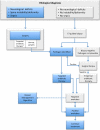Spinal infection: state of the art and management algorithm
- PMID: 23756630
- PMCID: PMC3843785
- DOI: 10.1007/s00586-013-2850-1
Spinal infection: state of the art and management algorithm
Abstract
Introduction: Spinal infection is a rare pathology although a concerning rising incidence has been observed in recent years. This increase might reflect a progressively more susceptible population but also the availability of increased diagnostic accuracy. Yet, even with improved diagnosis tools and procedures, the delay in diagnosis remains an important issue. This review aims to highlight the importance of a methodological attitude towards accurate and prompt diagnosis using an algorithm to aid on spinal infection management.
Methods: Appropriate literature on spinal infection was selected using databases from the US National Library of Medicine and the National Institutes of Health.
Results: Literature reveals that histopathological analysis of infected tissues is a paramount for diagnosis and must be performed routinely. Antibiotic therapy is transversal to both conservative and surgical approaches and must be initiated after etiological diagnosis. Indications for surgical treatment include neurological deficits or sepsis, spine instability and/or deformity, presence of epidural abscess and upon failure of conservative treatment.
Conclusions: A methodological assessment could lead to diagnosis effectiveness of spinal infection. Towards this, we present a management algorithm based on literature findings.
Figures


References
-
- Tayles N, Buckley HR. Leprosy and tuberculosis in iron age southeast Asia? Am J Phys Anthropol. 2004;125(3):239–256. - PubMed
-
- Camillo FX. Infections of the spine. In: Canale ST, Beaty JH, editors. Campbell’s operative orthopaedics. Philadelphia: Mosby Elsevier; 2008.
-
- Frangen TM, et al. Surgical management of spondylodiscitis. An analysis of 78 cases. Unfallchirurg. 2006;109(9):743–753. - PubMed
-
- Butler JS, et al. Nontuberculous pyogenic spinal infection in adults: a 12-year experience from a tertiary referral center. Spine (Phila Pa 1976) 2006;31(23):2695–2700. - PubMed
Publication types
MeSH terms
Substances
LinkOut - more resources
Full Text Sources
Other Literature Sources
Medical

